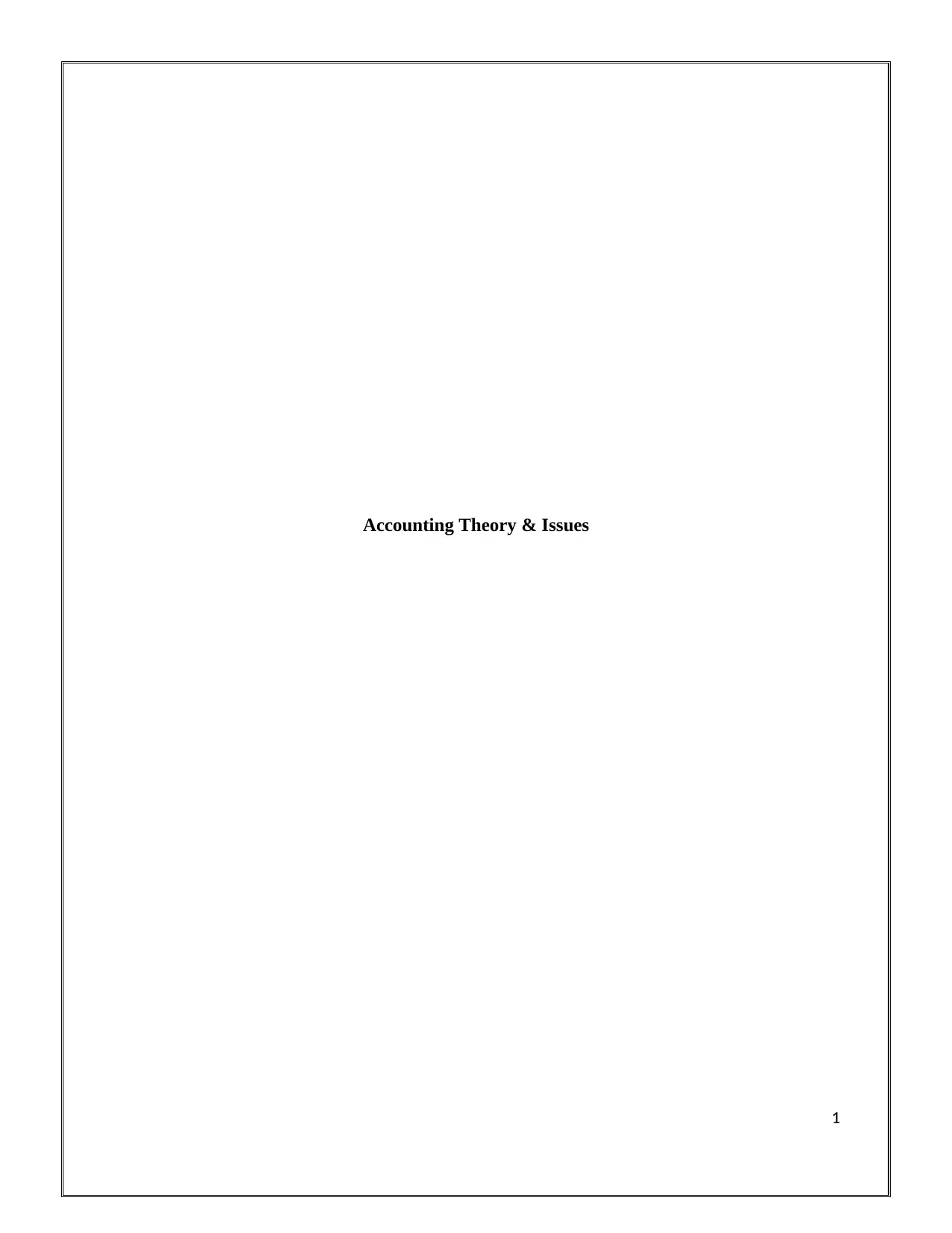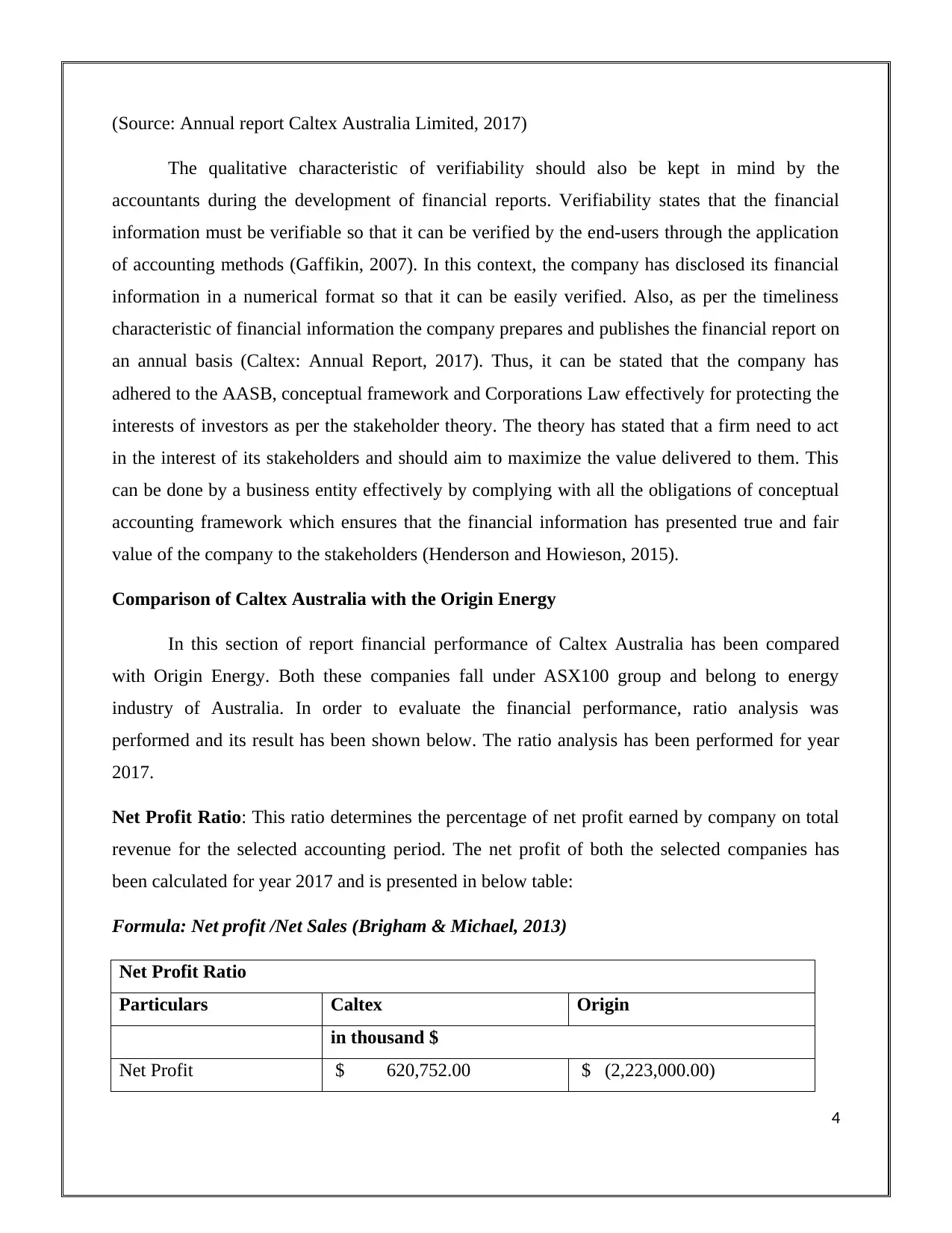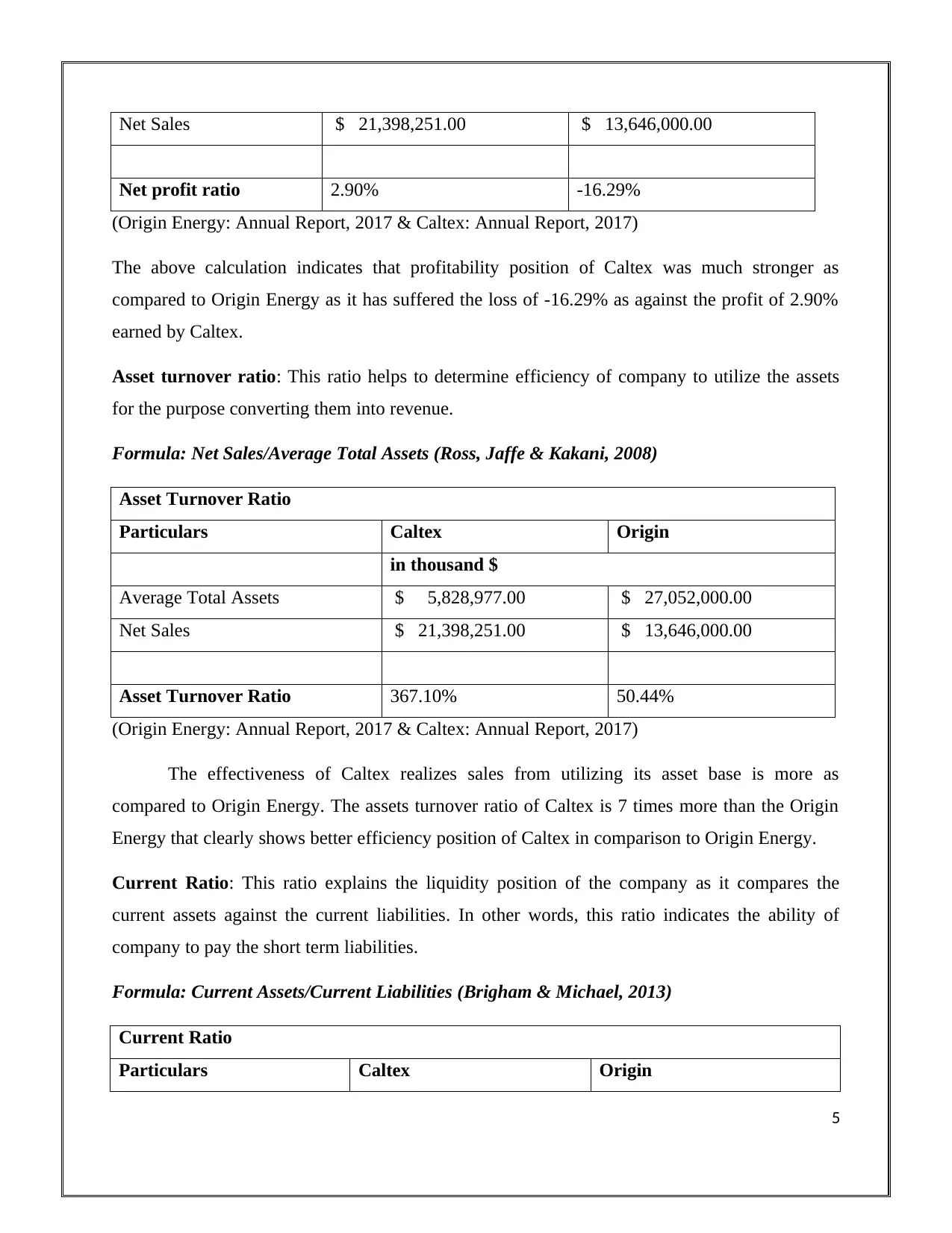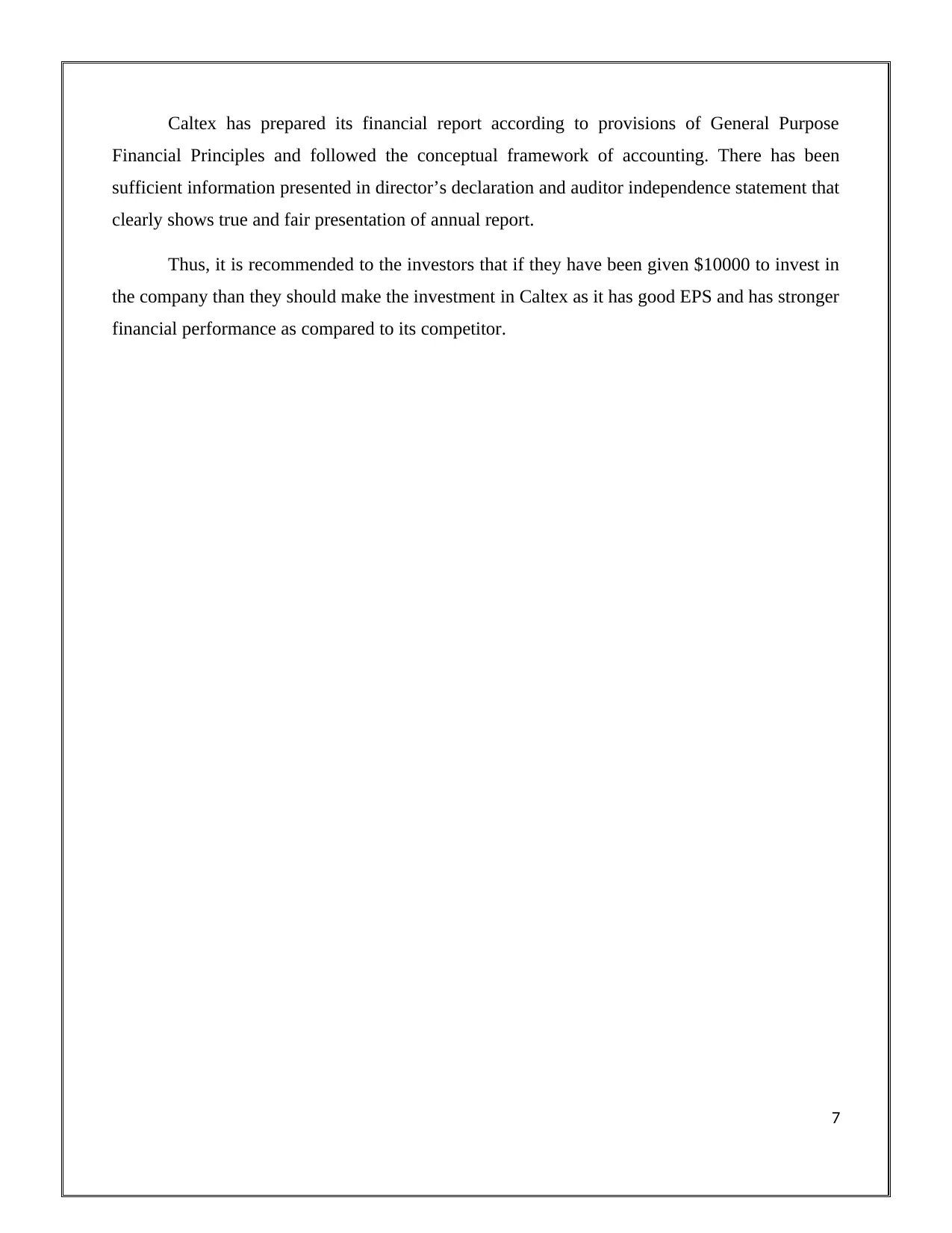Financial Reporting Analysis of Caltex Australia Limited
VerifiedAdded on 2023/06/08
|8
|1832
|355
Report
AI Summary
This report critically analyzes Caltex Australia Limited's application of General Purpose Financial Reporting, examining its effectiveness in meeting the obligations of the conceptual accounting framework as directed by the Australian Accounting Standards Board (AASB). It compares Caltex's annual report with that of Origin Energy, focusing on adherence to AASB, conceptual framework, and corporation law, using ratio analysis to compare the company's net profit ratio, asset turnover ratio, current ratio, and earnings per share. The analysis reveals that Caltex has a stronger profitability position, better efficiency in utilizing assets, and a positive EPS, making it a potentially favorable investment compared to Origin Energy. The report concludes that Caltex's financial reporting aligns with stakeholder theory, presenting a true and fair view to stakeholders, and recommends investment in Caltex based on its financial performance and compliance with accounting standards; access more solved assignments and reports on Desklib.

Accounting Theory & Issues
1
1
Paraphrase This Document
Need a fresh take? Get an instant paraphrase of this document with our AI Paraphraser

Introduction
The present report is developed for providing a critical analysis of the application of
General Purpose Financial Reporting by business corporations. This is carried out by examining
the effectiveness of an ASX listed business entity to meet the obligations of the conceptual
framework of accounting. Australian Accounting Standards Board (AASB) ahs directed the all
the business entities listed on ASX to follow the conceptual framework of accounting for
improving the quality of financial reporting. The business entity selected is Caltex Australia
Limited that is involved in purchasing, refining, distribution and selling the petroleum products
within Australia and New Zealand. The critical analysis of the annual report of the selected
business entity is done by comparing it with annual report of another corporation by considering
their adherence to AASB, conceptual framework and corporation’s law. At last, the report also
discusses the investment feasibility of the selected company for investors on the basis of critical
analysis of its annual report.
Critical Analysis of Annual Report of Caltex Australia
Caltex Australia, an ASX listed entity, need to comply with AASB, conceptual
framework and Corporations Law for developing and publishing its financial report. The
company needs to adhere to all the principles of conceptual framework of accounting stated by
IASB. The framework has stated relevance and faithful presentation of information to be
fundamental characteristics of financial reporting. In addition to this, the enhanced qualitative
characteristics of financial reporting as stated by the framework are understandability,
comparability, verifiability and timeliness. The relevance feature of the accounting framework
has stated that the financial information disclosed by an entity should have both a predictive and
confirmatory value. Caltex Australia, has adopted the use of historical experience for estimating
the expected value of financial items in the future context. The confirmatory value of financial
items is also stated in the general purpose financial statement that is calculated by the use of
specific accounting policies (Bazley and Robinson, 2014).
The faithful presentation of information characteristic of conceptual accounting
framework has stated that the financial reports must disclose the information that is complete in
all aspects and free from any type of materialistic error (Carlon, 2012). The company has
2
The present report is developed for providing a critical analysis of the application of
General Purpose Financial Reporting by business corporations. This is carried out by examining
the effectiveness of an ASX listed business entity to meet the obligations of the conceptual
framework of accounting. Australian Accounting Standards Board (AASB) ahs directed the all
the business entities listed on ASX to follow the conceptual framework of accounting for
improving the quality of financial reporting. The business entity selected is Caltex Australia
Limited that is involved in purchasing, refining, distribution and selling the petroleum products
within Australia and New Zealand. The critical analysis of the annual report of the selected
business entity is done by comparing it with annual report of another corporation by considering
their adherence to AASB, conceptual framework and corporation’s law. At last, the report also
discusses the investment feasibility of the selected company for investors on the basis of critical
analysis of its annual report.
Critical Analysis of Annual Report of Caltex Australia
Caltex Australia, an ASX listed entity, need to comply with AASB, conceptual
framework and Corporations Law for developing and publishing its financial report. The
company needs to adhere to all the principles of conceptual framework of accounting stated by
IASB. The framework has stated relevance and faithful presentation of information to be
fundamental characteristics of financial reporting. In addition to this, the enhanced qualitative
characteristics of financial reporting as stated by the framework are understandability,
comparability, verifiability and timeliness. The relevance feature of the accounting framework
has stated that the financial information disclosed by an entity should have both a predictive and
confirmatory value. Caltex Australia, has adopted the use of historical experience for estimating
the expected value of financial items in the future context. The confirmatory value of financial
items is also stated in the general purpose financial statement that is calculated by the use of
specific accounting policies (Bazley and Robinson, 2014).
The faithful presentation of information characteristic of conceptual accounting
framework has stated that the financial reports must disclose the information that is complete in
all aspects and free from any type of materialistic error (Carlon, 2012). The company has
2

complied with this principle also effectively as it has included the statement of director’s and
auditors to ensure that financial report is faithfully presented as depicted below:
(Source: Annual report Caltex Australia Limited, 2017)
It can be stated form the statement of director’s and auditor’s that the company has
developed the financial statements as per the accounting standards of AASB and following the
corporation’s Law to present true and fair value of the key financial items such as assets,
liabilities, equity and others. The company as per the understandability characteristic of
conceptual accounting framework has disclosed the relevant accounting policies and methods
that are used for developing the financial report. The notes section of the financial report of the
company has discussed the type of accounting practices and techniques that are used in recording
the value of key financial items as depicted below (Caltex: Annual Report, 2017):
(Source: Annual report Caltex Australia Limited, 2017)
The comparability characteristic of conceptual accounting framework has provided that
business entities need to present the financial information in a comparable manner so that it is
easy for the investors to analyze the percentage growth or decline in its financial performance as
compared with the previous year. As per this characteristic, the general purpose financial
statement of Caltex has been presented in a comparable format by depicting the comparisons of
the key financial items value with that of the previous year (IFRS Conceptual Framework, 2018).
The same has been depicted below:
3
auditors to ensure that financial report is faithfully presented as depicted below:
(Source: Annual report Caltex Australia Limited, 2017)
It can be stated form the statement of director’s and auditor’s that the company has
developed the financial statements as per the accounting standards of AASB and following the
corporation’s Law to present true and fair value of the key financial items such as assets,
liabilities, equity and others. The company as per the understandability characteristic of
conceptual accounting framework has disclosed the relevant accounting policies and methods
that are used for developing the financial report. The notes section of the financial report of the
company has discussed the type of accounting practices and techniques that are used in recording
the value of key financial items as depicted below (Caltex: Annual Report, 2017):
(Source: Annual report Caltex Australia Limited, 2017)
The comparability characteristic of conceptual accounting framework has provided that
business entities need to present the financial information in a comparable manner so that it is
easy for the investors to analyze the percentage growth or decline in its financial performance as
compared with the previous year. As per this characteristic, the general purpose financial
statement of Caltex has been presented in a comparable format by depicting the comparisons of
the key financial items value with that of the previous year (IFRS Conceptual Framework, 2018).
The same has been depicted below:
3
⊘ This is a preview!⊘
Do you want full access?
Subscribe today to unlock all pages.

Trusted by 1+ million students worldwide

(Source: Annual report Caltex Australia Limited, 2017)
The qualitative characteristic of verifiability should also be kept in mind by the
accountants during the development of financial reports. Verifiability states that the financial
information must be verifiable so that it can be verified by the end-users through the application
of accounting methods (Gaffikin, 2007). In this context, the company has disclosed its financial
information in a numerical format so that it can be easily verified. Also, as per the timeliness
characteristic of financial information the company prepares and publishes the financial report on
an annual basis (Caltex: Annual Report, 2017). Thus, it can be stated that the company has
adhered to the AASB, conceptual framework and Corporations Law effectively for protecting the
interests of investors as per the stakeholder theory. The theory has stated that a firm need to act
in the interest of its stakeholders and should aim to maximize the value delivered to them. This
can be done by a business entity effectively by complying with all the obligations of conceptual
accounting framework which ensures that the financial information has presented true and fair
value of the company to the stakeholders (Henderson and Howieson, 2015).
Comparison of Caltex Australia with the Origin Energy
In this section of report financial performance of Caltex Australia has been compared
with Origin Energy. Both these companies fall under ASX100 group and belong to energy
industry of Australia. In order to evaluate the financial performance, ratio analysis was
performed and its result has been shown below. The ratio analysis has been performed for year
2017.
Net Profit Ratio: This ratio determines the percentage of net profit earned by company on total
revenue for the selected accounting period. The net profit of both the selected companies has
been calculated for year 2017 and is presented in below table:
Formula: Net profit /Net Sales (Brigham & Michael, 2013)
Net Profit Ratio
Particulars Caltex Origin
in thousand $
Net Profit $ 620,752.00 $ (2,223,000.00)
4
The qualitative characteristic of verifiability should also be kept in mind by the
accountants during the development of financial reports. Verifiability states that the financial
information must be verifiable so that it can be verified by the end-users through the application
of accounting methods (Gaffikin, 2007). In this context, the company has disclosed its financial
information in a numerical format so that it can be easily verified. Also, as per the timeliness
characteristic of financial information the company prepares and publishes the financial report on
an annual basis (Caltex: Annual Report, 2017). Thus, it can be stated that the company has
adhered to the AASB, conceptual framework and Corporations Law effectively for protecting the
interests of investors as per the stakeholder theory. The theory has stated that a firm need to act
in the interest of its stakeholders and should aim to maximize the value delivered to them. This
can be done by a business entity effectively by complying with all the obligations of conceptual
accounting framework which ensures that the financial information has presented true and fair
value of the company to the stakeholders (Henderson and Howieson, 2015).
Comparison of Caltex Australia with the Origin Energy
In this section of report financial performance of Caltex Australia has been compared
with Origin Energy. Both these companies fall under ASX100 group and belong to energy
industry of Australia. In order to evaluate the financial performance, ratio analysis was
performed and its result has been shown below. The ratio analysis has been performed for year
2017.
Net Profit Ratio: This ratio determines the percentage of net profit earned by company on total
revenue for the selected accounting period. The net profit of both the selected companies has
been calculated for year 2017 and is presented in below table:
Formula: Net profit /Net Sales (Brigham & Michael, 2013)
Net Profit Ratio
Particulars Caltex Origin
in thousand $
Net Profit $ 620,752.00 $ (2,223,000.00)
4
Paraphrase This Document
Need a fresh take? Get an instant paraphrase of this document with our AI Paraphraser

Net Sales $ 21,398,251.00 $ 13,646,000.00
Net profit ratio 2.90% -16.29%
(Origin Energy: Annual Report, 2017 & Caltex: Annual Report, 2017)
The above calculation indicates that profitability position of Caltex was much stronger as
compared to Origin Energy as it has suffered the loss of -16.29% as against the profit of 2.90%
earned by Caltex.
Asset turnover ratio: This ratio helps to determine efficiency of company to utilize the assets
for the purpose converting them into revenue.
Formula: Net Sales/Average Total Assets (Ross, Jaffe & Kakani, 2008)
Asset Turnover Ratio
Particulars Caltex Origin
in thousand $
Average Total Assets $ 5,828,977.00 $ 27,052,000.00
Net Sales $ 21,398,251.00 $ 13,646,000.00
Asset Turnover Ratio 367.10% 50.44%
(Origin Energy: Annual Report, 2017 & Caltex: Annual Report, 2017)
The effectiveness of Caltex realizes sales from utilizing its asset base is more as
compared to Origin Energy. The assets turnover ratio of Caltex is 7 times more than the Origin
Energy that clearly shows better efficiency position of Caltex in comparison to Origin Energy.
Current Ratio: This ratio explains the liquidity position of the company as it compares the
current assets against the current liabilities. In other words, this ratio indicates the ability of
company to pay the short term liabilities.
Formula: Current Assets/Current Liabilities (Brigham & Michael, 2013)
Current Ratio
Particulars Caltex Origin
5
Net profit ratio 2.90% -16.29%
(Origin Energy: Annual Report, 2017 & Caltex: Annual Report, 2017)
The above calculation indicates that profitability position of Caltex was much stronger as
compared to Origin Energy as it has suffered the loss of -16.29% as against the profit of 2.90%
earned by Caltex.
Asset turnover ratio: This ratio helps to determine efficiency of company to utilize the assets
for the purpose converting them into revenue.
Formula: Net Sales/Average Total Assets (Ross, Jaffe & Kakani, 2008)
Asset Turnover Ratio
Particulars Caltex Origin
in thousand $
Average Total Assets $ 5,828,977.00 $ 27,052,000.00
Net Sales $ 21,398,251.00 $ 13,646,000.00
Asset Turnover Ratio 367.10% 50.44%
(Origin Energy: Annual Report, 2017 & Caltex: Annual Report, 2017)
The effectiveness of Caltex realizes sales from utilizing its asset base is more as
compared to Origin Energy. The assets turnover ratio of Caltex is 7 times more than the Origin
Energy that clearly shows better efficiency position of Caltex in comparison to Origin Energy.
Current Ratio: This ratio explains the liquidity position of the company as it compares the
current assets against the current liabilities. In other words, this ratio indicates the ability of
company to pay the short term liabilities.
Formula: Current Assets/Current Liabilities (Brigham & Michael, 2013)
Current Ratio
Particulars Caltex Origin
5

in thousand $
Current Assets $ 2,727,623.00 $ 5,011,000.00
Current Liabilities $ 2,358,669.00 $ 3,854,000.00
Current Ratio 1.16 1.30
(Origin Energy: Annual Report, 2017 & Caltex: Annual Report, 2017)
The liquidity position of Origin Energy was better than the Caltex however both the
companies have enough current assets to bear short term liabilities.
Earnings per Share: This ratio is very important form the investor’s point of view as it shows
earnings realized by shareholders on each share.
Formula: Net Profit attributable to the shareholders/Weighted average number of equity
shares (Ross, Jaffe & Kakani, 2008)
Earnings per share
Particulars Caltex Origin
in thousand $
Net Profit attributable to shareholders $ 620,752.00 $ (2,223,000.00)
Number of Shares 261000.00 1,754,489
EPS (In $) $ 2.38 $ (1.27)
(Origin Energy: Annual Report, 2017 & Caltex: Annual Report, 2017)
EPS of Caltex was positive $ 2.38 while it was negative $1.27 for Origin Energy that
clearly shows market performance of Caltex was much better than Origin Energy.
Recommendation and Conclusion
It can be stated from the overall discussion that the overall financial performance of
Caltex is better as compared to its competitor Origin Energy. However, Caltex net profit
percentage is not in year 2017 but it seems in future years there is huge scope of increase in its
profitability performance.
6
Current Assets $ 2,727,623.00 $ 5,011,000.00
Current Liabilities $ 2,358,669.00 $ 3,854,000.00
Current Ratio 1.16 1.30
(Origin Energy: Annual Report, 2017 & Caltex: Annual Report, 2017)
The liquidity position of Origin Energy was better than the Caltex however both the
companies have enough current assets to bear short term liabilities.
Earnings per Share: This ratio is very important form the investor’s point of view as it shows
earnings realized by shareholders on each share.
Formula: Net Profit attributable to the shareholders/Weighted average number of equity
shares (Ross, Jaffe & Kakani, 2008)
Earnings per share
Particulars Caltex Origin
in thousand $
Net Profit attributable to shareholders $ 620,752.00 $ (2,223,000.00)
Number of Shares 261000.00 1,754,489
EPS (In $) $ 2.38 $ (1.27)
(Origin Energy: Annual Report, 2017 & Caltex: Annual Report, 2017)
EPS of Caltex was positive $ 2.38 while it was negative $1.27 for Origin Energy that
clearly shows market performance of Caltex was much better than Origin Energy.
Recommendation and Conclusion
It can be stated from the overall discussion that the overall financial performance of
Caltex is better as compared to its competitor Origin Energy. However, Caltex net profit
percentage is not in year 2017 but it seems in future years there is huge scope of increase in its
profitability performance.
6
⊘ This is a preview!⊘
Do you want full access?
Subscribe today to unlock all pages.

Trusted by 1+ million students worldwide

Caltex has prepared its financial report according to provisions of General Purpose
Financial Principles and followed the conceptual framework of accounting. There has been
sufficient information presented in director’s declaration and auditor independence statement that
clearly shows true and fair presentation of annual report.
Thus, it is recommended to the investors that if they have been given $10000 to invest in
the company than they should make the investment in Caltex as it has good EPS and has stronger
financial performance as compared to its competitor.
7
Financial Principles and followed the conceptual framework of accounting. There has been
sufficient information presented in director’s declaration and auditor independence statement that
clearly shows true and fair presentation of annual report.
Thus, it is recommended to the investors that if they have been given $10000 to invest in
the company than they should make the investment in Caltex as it has good EPS and has stronger
financial performance as compared to its competitor.
7
Paraphrase This Document
Need a fresh take? Get an instant paraphrase of this document with our AI Paraphraser

References
Bazley, M. & Robinson, P. (2014.) Contemporary Accounting PDF. Cengage Learning
Australia.
Brigham, F., & Michael C. (2013). Financial management: Theory & practice. Cengage
Learning.
Caltex: Annual Report. (2017). Retrieved 6 September, 2018 from
https://www.caltex.com.au/our-company/investor-centre/annual-reports-and-reviews
Carlon, S. (2012). Accounting, Google eBook: Building Business Skills. John Wiley & Sons.
Gaffikin, M. (2007). Corporate Accounting in Australia. UNSW Press.
Henderson, S. & Howieson, B. (2015). Issues in Financial Accounting. Pearson Higher
Education AU.
IFRS Conceptual Framework. (2018). Conceptual Framework for Financial Reporting. Retrieved
6 September, 2018 from https://www.ifrs.org/-/media/project/conceptual-framework/fact-
sheet-project-summary-and-feedback-statement/conceptual-framework-project-
summary.pdf
Origin Energy: Annual Report. (2017). Retrieved 6 September, 2018 from
https://www.originenergy.com.au/content/dam/origin/about/investors-media/annual
%20review%202017/AnnualReport_FY2017.pdf
Ross, A., Jaffe, J. & Kakani, R.K. (2008). Corporate Finance. Pearson.
8
Bazley, M. & Robinson, P. (2014.) Contemporary Accounting PDF. Cengage Learning
Australia.
Brigham, F., & Michael C. (2013). Financial management: Theory & practice. Cengage
Learning.
Caltex: Annual Report. (2017). Retrieved 6 September, 2018 from
https://www.caltex.com.au/our-company/investor-centre/annual-reports-and-reviews
Carlon, S. (2012). Accounting, Google eBook: Building Business Skills. John Wiley & Sons.
Gaffikin, M. (2007). Corporate Accounting in Australia. UNSW Press.
Henderson, S. & Howieson, B. (2015). Issues in Financial Accounting. Pearson Higher
Education AU.
IFRS Conceptual Framework. (2018). Conceptual Framework for Financial Reporting. Retrieved
6 September, 2018 from https://www.ifrs.org/-/media/project/conceptual-framework/fact-
sheet-project-summary-and-feedback-statement/conceptual-framework-project-
summary.pdf
Origin Energy: Annual Report. (2017). Retrieved 6 September, 2018 from
https://www.originenergy.com.au/content/dam/origin/about/investors-media/annual
%20review%202017/AnnualReport_FY2017.pdf
Ross, A., Jaffe, J. & Kakani, R.K. (2008). Corporate Finance. Pearson.
8
1 out of 8
Related Documents
Your All-in-One AI-Powered Toolkit for Academic Success.
+13062052269
info@desklib.com
Available 24*7 on WhatsApp / Email
![[object Object]](/_next/static/media/star-bottom.7253800d.svg)
Unlock your academic potential
Copyright © 2020–2025 A2Z Services. All Rights Reserved. Developed and managed by ZUCOL.





